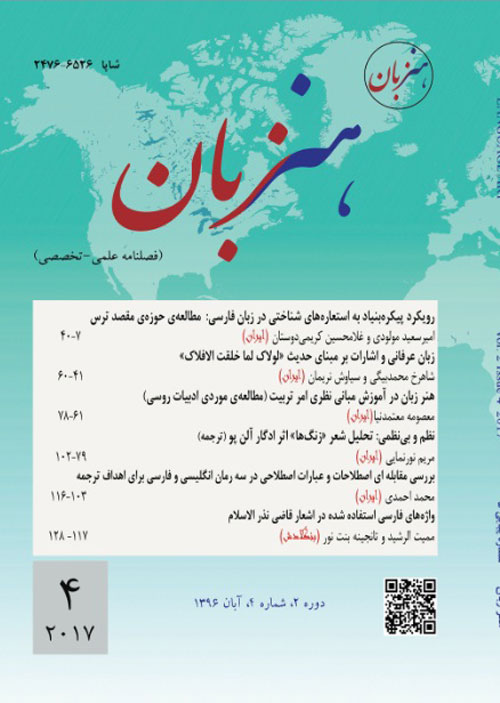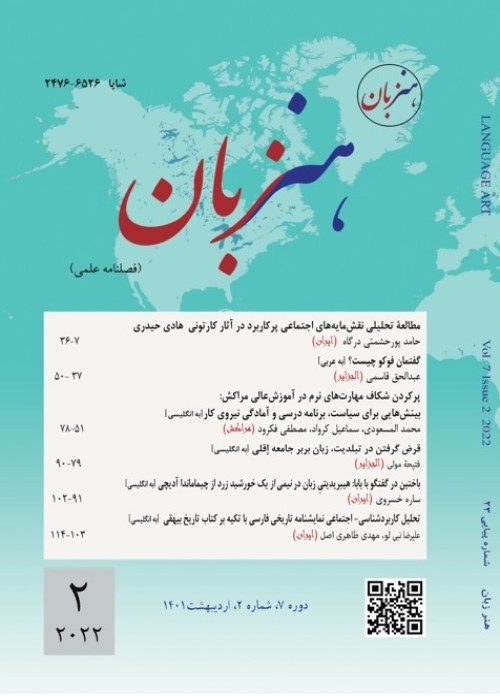فهرست مطالب

نشریه هنر زبان
سال دوم شماره 4 (آبان 1396)
- تاریخ انتشار: 1396/09/30
- تعداد عناوین: 6
- مقاله
-
هنر زبان در آموزش مبانی نظری امر تربیت (مطالعه موردی ادبیات روسی)صفحات 61-78
- گزارش
-
صفحات 79-102
- مقاله
-
صفحات 117-128
-
Pages 7-40The present research investigates the metaphorical conceptualization of fear target domain in Persian based on Conceptual Theory of Metaphor. For the mentioned purpose, the Corpus-based method of Metaphorical Pattern Analysis is applied to Hamshahri Corpus 2 and after data analysis, 39 source domains are identified for the fear target domain. One of the results of this research is determining the productivity of all the source domains based on their frequency of occurrences in the corpus. Also, after comparing the results of the present research with those of ones in which collecting data for fear domain has been done by traditional methods, the superiority of the Corpus-based method of the present research is approved. Another significant finding of the present research is the identification of prototypical and nonprototypical models of the fear target domain in Persian.Keywords: Conceptual Theory of Metaphor, Fear Target Domain, Corpus-based Method, Productivity
-
Pages 41-60Mystics have used the concepts of Quranic Verses as well as the Celestial Hadiths and Prophet's traditions remarkably to state their elegant and revelatory attitudes. Through this, they have not only made their theories holy, but also cited verses and traditions to prove their claims. Those who are making spiritual progress have gone beyond the apparent meaning of the traditions, and attempted to explore the concealed meaning of traditions, their internal paraphrase and justification. One of these traditions which have received much attention from the wise people is the Celestial Hadith of law lāka lamā xalaqtol aflāk (God Told: O' Mohammed, I created the world for the sake of you). This divine word has become the wealth of the fascinated and wayfarers that each of them considered it based on their own taste and inclination. The essence of the attitudes of mystics reveals the fact that the final goal of creation is the character of Mohammed (Peace Be Upon Him) and His abluent Family, who are the best reflection of God's Names and Properties. In this dispute, this Celestial Hadith has been examined and investigated in terms of documentation, difference in terminology, the reason of relationship among the creation of the Prophet Mohammad (PBUH), the Worlds of Existence, and the position of the Prophet (PBUH) in this world and the Eternity.Keywords: Interpretation, Paraphrase, the Celestial Hadith, the Great Mohammed (PBUH), Mysticism
-
The Art of Language in Teaching Theoretical Basics of Education (A Case Study: Russian Literature)Pages 61-78The nature of teaching foreign language literature, especially the Russian literature which is formed by a great wealth of Russian culture based on the learning of the stable communication principles, providing its facilities is charged on the foreign language departments of universities. This communicational method is of high importance because it is a good way for students to become acquainted with the spiritual and cultural values of the other nations and the mutual understanding between people. Literature, in any forms and shapes, reflects the life and expresses the values, criteria and characteristics affecting the individual and collective life. Literary works occasionally connect to life from the ethnic and national perspectives, and sometimes from the viewpoint of sensation and emotion, and at times, through rationality and morality, it guides and instructs its audiences. The use of literature in enhancing reading skills and the way it is used to create mental peace as well as its use as a means of gaining new experiences are the strategies which have been investigated in this article. The use of language and literature in the formation of educational beliefs in individuals constitutes the final section of this study.Keywords: Education, Educational Linguistics, Russia, Foreign Language
-
Pages 79-102In this article, U. Marie Engemann has tried to indicate the method and internal cohesion of The Bells: a poem by Edgar Allan Poe, regardless of its apparent madness. This poem consists of four stanzas each of which is a symbol of a stage in the human's life for which a specific bell has been dedicated to. This poem follows trochaic meter in which the poet ingeniously has used catalexis in order to imitate the chime of bells. Throughout the poem, he has used different sound devices such as rhyme, sound patterning, alliteration, and onomatopoeia to create parallelism, and accordingly, he has conformed the chime of the bells to the dominant feature of each stage of life; thus, a meaningful cohesion has been created. This article can show how a poet may use different sound devices of his own language to create a parallelism between sound symbolism and meaning. The structure of the article has been changed a little by inserting the figures and the tables in the appendices into its straight text in translation so that it becomes easier for the readers to make a link between discussions and the data presented in each figure or table.Keywords: Trochaic Meter, Rhyme, Parallelism, Assonance, Consonance, Catalexis
-
Pages 103-116The significance of idioms and idiomatic expressions in English can be understood from their appearance in all types of discourse ranging from every day conversations to scientific texts. So, the present study deals with the translation of idioms and idiomatic expressions from English into Persian focusing on the procedures involved. Baker's model (1992) which groups possible procedures into four strategies was chosen as the theoretical framework of this research. This study is an attempt to investigate strategies used in translating and also to find out which strategy is mostly used. To do so, a total number of 90 idioms and idiomatic expressions were extracted from three English novels. This study was carried out through a comparative study of idioms and idiomatic expressions from English into Persian. The findings of the research indicated that four strategies were used in translating idioms and idiomatic expressions and their frequency of being used is different and also it was revealed that most of the data were translated by paraphrase.Keywords: Idioms, Idiomatic Expressions, Paraphrase, Translation
-
Pages 117-128Kazi Nazrul Islam, the national poet of Bangladesh, popularly known as Nazrul-the rebel poet, is undoubtedly one who may rightly be called as one of the greatest poets of people of the world. He was the first poet in Bengali literature that used extensive Arabic and Persian words to express his views and to create a Muslim renaissance within the whole Bengali nation. He was a multi-lingual poet. Thats why we see huge Arabic, Persian, Hindi, Sanskrit and Urdu words, even sentences in almost everywhere of his literature. This article is about the Persian words that Nazrul had used in his poetry. Though the majority of his poems consists of more or less Persian words, in this article, we discussed five of his poems named Shat-ilArab, Moharram, Kamal Pasha, Qorbani and the 12th Fateha that has most Persian words comparatively.Keywords: Kazi Nazrul Islam, Persian Words, Shat-il-Arab, Moharram, Kamal Pasha, Korbani, the 12th Fateha


